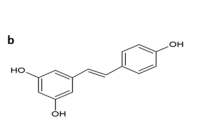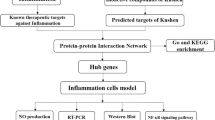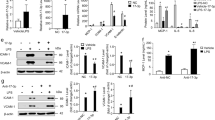Abstract
Aim:
To investigate whether curcumin (Cur) suppressed lipopolysaccharide (LPS)-induced inflammation in vascular smooth muscle cells (VSMCs) of rats, and to determine its molecular mechanisms.
Methods:
Primary rat VSMCs were treated with LPS (1 μg/L) and Cur (5, 10, or 30 μmol/L) for 24 h. The levels of MCP-1, TNF-α, and iNOS were measured using ELISA and real-time RT-PCR. NO level was analyzed with the Griess reaction. Western-blotting was used to detect the activation of TLR4, MAPKs, IκBα, NF-κB p65, and the p47phox subunit of NADPH oxidase in the cells.
Results:
Treatment of VSMCs with LPS dramatically increased expression of inflammatory cytokines MCP-1 and TNF-α, expression of TLR4 and iNOS, and NO production. LPS also significantly increased phosphorylation of IκBα, nuclear translocation of NF-κB (p65) and phosphorylation of MAPKs in VSMCs. Furthermore, LPS significantly increased production of intracellular ROS, and decreased expression of p47phox subunit of NADPH oxidase. Pretreatment with Cur concentration-dependently attenuated all the aberrant changes in LPS-treated VSMCs. The LPS-induced overexpression of MCP-1 and TNF-α, and NO production were attenuated by pretreatment with the ERK inhibitor PD98059, the p38 MAPK inhibitor SB203580, the NF-κB inhibitor PDTC or anti-TLR4 antibody, but not with the JNK inhibitor SP600125.
Conclusion:
Cur suppresses LPS-induced overexpression of inflammatory mediators in VSMCs in vitro via inhibiting the TLR4-MAPK/NF-κB pathways, partly due to block of NADPH-mediated intracellular ROS production.
Similar content being viewed by others
Log in or create a free account to read this content
Gain free access to this article, as well as selected content from this journal and more on nature.com
or
References
Libby P, Ridker PM, Hansson GK . Inflammation in atherosclerosis: from pathophysiology to practice. J Am Coll Cardiol 2009; 54: 2129–38.
Bae JH, Kim WS, Rihal CS, Lerman A . Individual measurement and significance of carotid intima, media, and intima-media thickness by B-mode ultrasonographic image processing. Arterioscler Thromb Vasc Biol 2006; 26: 2380–5.
Ji Y, Liu J, Wang Z, Li Z . PPARgamma agonist rosiglitazone ameliorates LPS-induced inflammation in vascular smooth muscle cells via the TLR4/TRIF/IRF3/IP-10 signaling pathway. Cytokine 2011; 55: 409–19.
Zhong Y, Liu T, Guo Z . Curcumin inhibits ox-LDL-induced MCP-1 expression by suppressing the p38MAPK and NF-kappaB pathways in rat vascular smooth muscle cells. Inflamm Res 2012; 61: 61–7.
Goel A, Kunnumakkara AB, Aggarwal BB . Curcumin as “Curecumin”: from kitchen to clinic. Biochem Pharmacol 2008; 75: 787–809.
Aggarwal BB, Kumar A, Bharti AC . Anticancer potential of curcumin: preclinical and clinical studies. Anticancer Res 2003; 23: 363–98.
Masuda T, Hidaka K, Shinohara A, Maekawa T, Takeda Y, Yamaguchi H . Chemical studies on antioxidant mechanism of curcuminoid: analysis of radical reaction products from curcumin. J Agric Food Chem 1999; 47: 71–7.
Sikora E, Scapagnini G, Barbagallo M . Curcumin, inflammation, ageing and age-related diseases. Immun Ageing 2010; 7: 1.
Olszanecki R, Jawień J, Gajda M, Mateuszuk L, Gebska A, Korabiowska M, et al. Effect of curcumin on atherosclerosis in apoE/LDLR-double knockout mice. J Physiol Pharmacol 2005; 56: 627–35.
den Dekker WK, Cheng C, Pasterkamp G, Duckers HJ . Toll like receptor 4 in atherosclerosis and plaque destabilization. Atherosclerosis 2010; 209: 314–20.
Edfeldt K, Swedenborg J, Hansson GK, Yan ZQ . Expression of toll-like receptors in human atherosclerotic lesions: a possible pathway for plaque activation. Circulation 2002; 105: 1158–61.
Michelsen KS, Wong MH, Shah PK, Zhang W, Yano J, Doherty TM, et al. Lack of Toll-like receptor 4 or myeloid differentiation factor 88 reduces atherosclerosis and alters plaque phenotype in mice deficient in apolipoprotein E. Proc Natl Acad Sci U S A 2004, 101: 10679–84.
Lubbad A, Oriowo MA, Khan I . Curcumin attenuates inflammation through inhibition of TLR-4 receptor in experimental colitis. Mol Cell Biochem 2009; 322: 127–35.
Baker RG, Hayden MS, Ghosh S . NF-kappaB, inflammation, and metabolic disease. Cell Metab 2011; 13: 11–22.
Kaminska B . MAPK signalling pathways as molecular targets for anti-inflammatory therapy-from molecular mechanisms to therapeutic benefits. Biochim Biophys Acta 2005; 1754: 253–62.
Luo XH, Guo LJ, Yuan LQ, Xie H, Zhou HD, Wu XP, et al. Adiponectin stimulates human osteoblasts proliferation and differentiation via the MAPK signaling pathway. Exp Cell Res 2005; 309: 99–109.
Zhang W, Liu HT . MAPK signal pathways in the regulation of cell proliferation in mammalian cells. Cell Res 2002; 12: 9–18.
Xing H, Zhang S, Weinheimer C, Kovacs A, Muslin AJ . 14-3-3 proteins block apoptosis and differentially regulate MAPK cascades. EMBO J 2000; 19: 349–58.
Son YH, Jeong YT, Lee KA, Choi KH, Kim SM, Rhim BY, et al. Roles of MAPK and NF-kappaB in interleukin-6 induction by lipopolysaccharide in vascular smooth muscle cells. J Cardiovasc Pharmacol 2008; 51: 71–7.
San Martin A, Foncea R, Laurindo FR, Ebensperger R, Griendling KK, Leighton F . Nox1-based NADPH oxidase-derived superoxide is required for VSMC activation by advanced glycation end-products. Free Radic Biol Med 2007; 42: 1671–9.
Whitton PS . Inflammation as a causative factor in the aetiology of Parkinson's disease. Br J Pharmacol 2007; 150: 963–76.
Griendling KK, Taubman MB, Akers M, Mendlowitz M, Alexander RW . Characterization of phosphatidylinositol-specific phospholipase C from cultured vascular smooth muscle cells. J Biol Chem 1991; 266: 15498–504.
Cho JY, Baik KU, Jung JH, Park MH . In vitro anti-inflammatory effects of cynaropicrin, a sesquiterpene lactone, from Saussurea lappa. Eur J Pharmacol 2000; 398: 399–407.
Jeong JM, Choi CH, Kang SK, Lee IH, Lee JY, Jung H . Antioxidant and chemosensitizing effects of flavonoids with hydroxy and/or methoxy groups and structure-activity relationship. J Pharm Pharm Sci 2007; 10: 537–46.
Levi M, van der Poll T, Schultz M . Infection and inflammation as risk factors for thrombosis and atherosclerosis. Semin Thromb Hemost 2012; 38: 506–14.
Libby P . Inflammation in atherosclerosis. Arterioscler Thromb Vasc Biol 2012; 32: 2045–51.
Nelken N A, Coughlin S R, Gordon D, Wilcox JN . Monocyte chemoattractant protein-1 in human atheromatous plaques. J Clin Invest 1991; 88: 1121–7.
Boyle JJ, Weissberg PL, Bennett MR . Tumor necrosis factor-alpha promotes macrophage-induced vascular smooth muscle cell apoptosis by direct and autocrine mechanisms. Arterioscler Thromb Vasc Biol 2003; 23: 1553–8.
Barks JL, Mcquillan JJ, Iademarco MF . TNF-alpha and IL-4 synergistically increase vascular cell adhesion molecule-1 expression in cultured vascular smooth muscle cells. J Immunol 1997; 159: 4532–8.
Ortego M, Bustos C, Hernández-Presa MA, Tuñón J, Díaz C, Hernández G, et al. Atorvastatin reduces NF-kappaB activation and chemokine expression in vascular smooth muscle cells and mononuclear cells. Atherosclerosis 1999; 147: 253–61.
Heo SK, Yun HJ, Noh EK, Park WH, Park SD . LPS induces inflammatory responses in human aortic vascular smooth muscle cells via Toll-like receptor 4 expression and nitric oxide production. Immunol Lett 2008; 120: 57–64.
Jiang P, Xu J, Zheng S, Huang J, Xiang Q, Fu X, et al. 17Beta-estradiol down-regulates lipopolysaccharide-induced MCP-1 production and cell migration in vascular smooth muscle cells. J Mol Endocrinol 2010; 45: 87–97.
Kumar A, Dhawan S, Hardegen NJ, Aggarwal BB . Curcumin (Diferuloylmethane) inhibition of tumor necrosis factor (TNF)-mediated adhesion of monocytes to endothelial cells by suppression of cell surface expression of adhesion molecules and of nuclear factor-kappaB activation. Biochem Pharmacol 1998; 55: 775–83.
Abe Y, Hashimoto S, Horie T . Curcumin inhibition of inflammatory cytokine production by human peripheral blood monocytes and alveolar macrophages. Pharmacol Res 1999; 39: 41–7.
Wever RM, Luscher TF, Cosentino F, Rabelink TJ . Atherosclerosis and the two faces of endothelial nitric oxide synthase. Circulation 1998; 97: 108–12.
Bunderson M, Coffin JD, Beall HD . Arsenic induces peroxynitrite generation and cyclooxygenase-2 protein expression in aortic endothelial cells: possible role in atherosclerosis. Toxicol Appl Pharmacol 2002; 184: 11–8.
Rubbo H, Trostchansky A, O'Donnell VB . Peroxynitrite-mediated lipid oxidation and nitration: mechanisms and consequences. Arch Biochem Biophys 2009; 484: 167–72.
Pfeiffer S, Schmidt K, Mayer B . Dityrosine formation outcompetes tyrosine nitration at low steady-state concentrations of peroxynitrite. Implications for tyrosine modification by nitric oxide/superoxide in vivo. J Biol Chem 2000; 275: 6346–52.
Kuhlencordt PJ, Chen J, Han F, Astern J, Huang PL . Genetic deficiency of inducible nitric oxide synthase reduces atherosclerosis and lowers plasma lipid peroxides in apolipoprotein E-knockout mice. Circulation 2001; 103: 3099–104.
Hayashi T, Matsui-Hirai H, Fukatsu A, Sumi D, Kano-Hayashi H, Rani PJ, et al. Selective iNOS inhibitor, ONO1714 successfully retards the development of high-cholesterol diet induced atherosclerosis by novel mechanism. Atherosclerosis 2006; 187: 316–24.
Li H, Sun B . Toll-like receptor 4 in atherosclerosis. J Cell Mol Med 2007; 11: 88–95.
Heo SK, Yun HJ, Noh EK, Park WH, Park SD . LPS induces inflammatory responses in human aortic vascular smooth muscle cells via Toll-like receptor 4 expression and nitric oxide production. Immunol Lett 2008; 120: 57–64.
Son YH, Jeong YT, Lee KA, Choi KH, Kim SM, Rhim BY, et al. Roles of MAPK and NF-kappaB in interleukin-6 induction by lipopolysaccharide in vascular smooth muscle cells. J Cardiovasc Pharmacol 2008; 51: 71–7.
Meng XL, Yang JY, Chen GL, Wang LH, Zhang LJ, Wang S, et al. Effects of resveratrol and its derivatives on lipopolysaccharide-induced microglial activation and their structure-activity relationships. Chem Biol Interact 2008; 174: 51–9.
Yang FL, Yang YL, Liao PC, Chou JC, Tsai KC, Yang AS, et al. Structure and immunological characterization of the capsular polysaccharide of a pyrogenic liver abscess caused by Klebsiella pneumoniae: activation of macrophages through Toll-like receptor 4. J Biol Chem 2011; 286: 21041–51.
Madamanchi NR, Runge MS . NADPH oxidases and atherosclerosis: unraveling the details. Am J Physiol Heart Circ Physiol 2010; 298: H1–H2.
Schiffrin EL, Touyz RM . Inflammation and vascular hypertrophy induced by angiotensin II: role of NADPH oxidase-derived reactive oxygen species independently of blood pressure elevation? Arterioscler Thromb Vasc Biol 2003; 23: 707–9.
Barry-Lane PA, Patterson C, van der Merwe M, Hu Z, Holland SM, Yeh ET, et al. p47phox is required for atherosclerotic lesion progression in ApoE−/− mice. J Clin Invest 2001; 108: 1513–22.
Zhang L, Wu C, Zhao S, Yuan D, Lian G, Wang X, et al. Demethoxycurcumin, a natural derivative of curcumin attenuates LPS-induced pro-inflammatory responses through down-regulation of intracellular ROS-related MAPK/NF-kappaB signaling pathways in N9 microglia induced by lipopolysaccharide. Int Immunopharmacol 2010; 10: 331–8.
He LF, Chen HJ, Qian LH, Chen GY, Buzby JS . Curcumin protects pre-oligodendrocytes from activated microglia in vitro and in vivo. Brain Res 2010; 1339: 60–9.
Acknowledgements
This study was supported by the National Natural Science Foundation of China [NSFC 81070219 to Xiao-lin NIU and NSFC 30900617 to Deng-feng GAO].
Author information
Authors and Affiliations
Corresponding authors
Rights and permissions
About this article
Cite this article
Meng, Z., Yan, C., Deng, Q. et al. Curcumin inhibits LPS-induced inflammation in rat vascular smooth muscle cells in vitro via ROS-relative TLR4-MAPK/NF-κB pathways. Acta Pharmacol Sin 34, 901–911 (2013). https://doi.org/10.1038/aps.2013.24
Received:
Accepted:
Published:
Issue date:
DOI: https://doi.org/10.1038/aps.2013.24
Keywords
This article is cited by
-
Emodin Attenuates Ozone-Induced Lung Injury Via TLR4/MYD88/NF-κB Signaling Pathways
Pharmaceutical Chemistry Journal (2023)
-
Beyond Glucose: The Dual Assault of Oxidative and ER Stress in Diabetic Disorders
High Blood Pressure & Cardiovascular Prevention (2023)
-
Recent advances in the molecular mechanisms of low-intensity pulsed ultrasound against inflammation
Journal of Molecular Medicine (2023)
-
Curcumin and chemokines: mechanism of action and therapeutic potential in inflammatory diseases
Inflammopharmacology (2023)
-
5-Methoxyflavone alleviates LPS-mediated lung injury by promoting Nrf2-mediated the suppression of NOX4/TLR4 axis in bronchial epithelial cells and M1 polarization in macrophages
Journal of Inflammation (2022)



